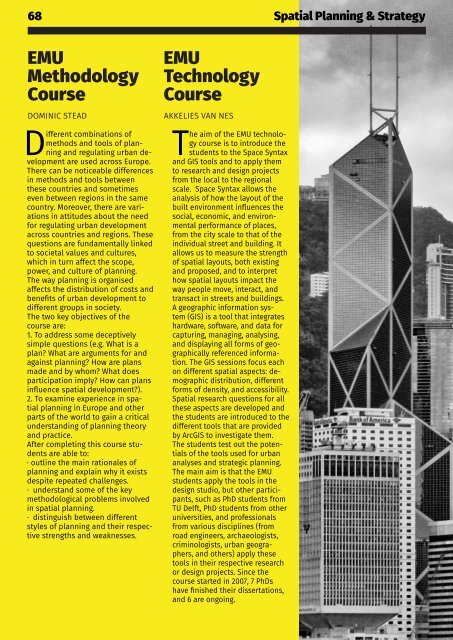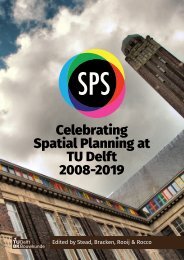*Celebrating Spatial Planning at TU Delft: 2008-2019. Edited by Stead, Bracken, Rooij & Rocco
This is a summary of the achievements of the session Spatial Planning & Strategy of the Department of Urbanism, Faculty of Architecture and the Built Environment, TU Delft, led by Professor Vincent Nadin between 2008 and 2019.
This is a summary of the achievements of the session Spatial Planning & Strategy of the Department of Urbanism, Faculty of Architecture and the Built Environment, TU Delft, led by Professor Vincent Nadin between 2008 and 2019.
You also want an ePaper? Increase the reach of your titles
YUMPU automatically turns print PDFs into web optimized ePapers that Google loves.
68 <strong>Sp<strong>at</strong>ial</strong> <strong>Planning</strong> & Str<strong>at</strong>egy<br />
EMU<br />
Methodology<br />
Course<br />
DOMINIC STEAD<br />
Different combin<strong>at</strong>ions of<br />
methods and tools of planning<br />
and regul<strong>at</strong>ing urban development<br />
are used across Europe.<br />
There can be noticeable differences<br />
in methods and tools between<br />
these countries and sometimes<br />
even between regions in the same<br />
country. Moreover, there are vari<strong>at</strong>ions<br />
in <strong>at</strong>titudes about the need<br />
for regul<strong>at</strong>ing urban development<br />
across countries and regions. These<br />
questions are fundamentally linked<br />
to societal values and cultures,<br />
which in turn affect the scope,<br />
power, and culture of planning.<br />
The way planning is organised<br />
affects the distribution of costs and<br />
benefits of urban development to<br />
different groups in society.<br />
The two key objectives of the<br />
course are:<br />
1. To address some deceptively<br />
simple questions (e.g. Wh<strong>at</strong> is a<br />
plan? Wh<strong>at</strong> are arguments for and<br />
against planning? How are plans<br />
made and <strong>by</strong> whom? Wh<strong>at</strong> does<br />
particip<strong>at</strong>ion imply? How can plans<br />
influence sp<strong>at</strong>ial development?).<br />
2. To examine experience in sp<strong>at</strong>ial<br />
planning in Europe and other<br />
parts of the world to gain a critical<br />
understanding of planning theory<br />
and practice.<br />
After completing this course students<br />
are able to:<br />
· outline the main r<strong>at</strong>ionales of<br />
planning and explain why it exists<br />
despite repe<strong>at</strong>ed challenges.<br />
· understand some of the key<br />
methodological problems involved<br />
in sp<strong>at</strong>ial planning.<br />
· distinguish between different<br />
styles of planning and their respective<br />
strengths and weaknesses.<br />
EMU<br />
Technology<br />
Course<br />
AKKELIES VAN NES<br />
The aim of the EMU technology<br />
course is to introduce the<br />
students to the Space Syntax<br />
and GIS tools and to apply them<br />
to research and design projects<br />
from the local to the regional<br />
scale. Space Syntax allows the<br />
analysis of how the layout of the<br />
built environment influences the<br />
social, economic, and environmental<br />
performance of places,<br />
from the city scale to th<strong>at</strong> of the<br />
individual street and building. It<br />
allows us to measure the strength<br />
of sp<strong>at</strong>ial layouts, both existing<br />
and proposed, and to interpret<br />
how sp<strong>at</strong>ial layouts impact the<br />
way people move, interact, and<br />
transact in streets and buildings.<br />
A geographic inform<strong>at</strong>ion system<br />
(GIS) is a tool th<strong>at</strong> integr<strong>at</strong>es<br />
hardware, software, and d<strong>at</strong>a for<br />
capturing, managing, analysing,<br />
and displaying all forms of geographically<br />
referenced inform<strong>at</strong>ion.<br />
The GIS sessions focus each<br />
on different sp<strong>at</strong>ial aspects: demographic<br />
distribution, different<br />
forms of density, and accessibility.<br />
<strong>Sp<strong>at</strong>ial</strong> research questions for all<br />
these aspects are developed and<br />
the students are introduced to the<br />
different tools th<strong>at</strong> are provided<br />
<strong>by</strong> ArcGIS to investig<strong>at</strong>e them.<br />
The students test out the potentials<br />
of the tools used for urban<br />
analyses and str<strong>at</strong>egic planning.<br />
The main aim is th<strong>at</strong> the EMU<br />
students apply the tools in the<br />
design studio, but other participants,<br />
such as PhD students from<br />
<strong>TU</strong> <strong>Delft</strong>, PhD students from other<br />
universities, and professionals<br />
from various disciplines (from<br />
road engineers, archaeologists,<br />
criminologists, urban geographers,<br />
and others) apply these<br />
tools in their respective research<br />
or design projects. Since the<br />
course started in 2007, 7 PhDs<br />
have finished their dissert<strong>at</strong>ions,<br />
and 6 are ongoing.




